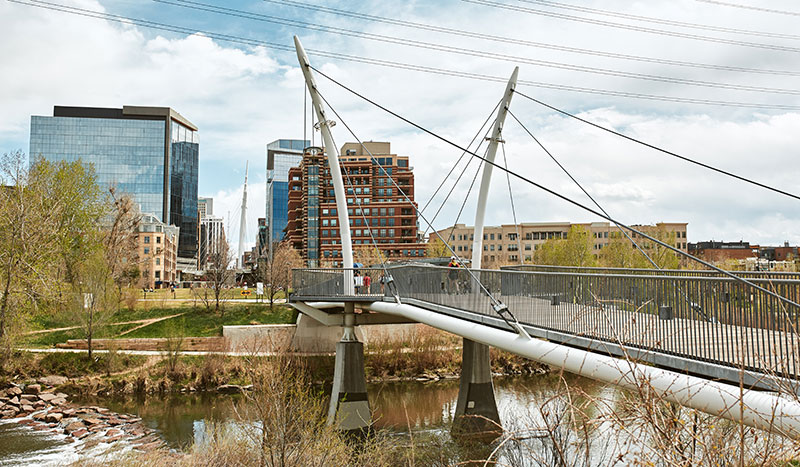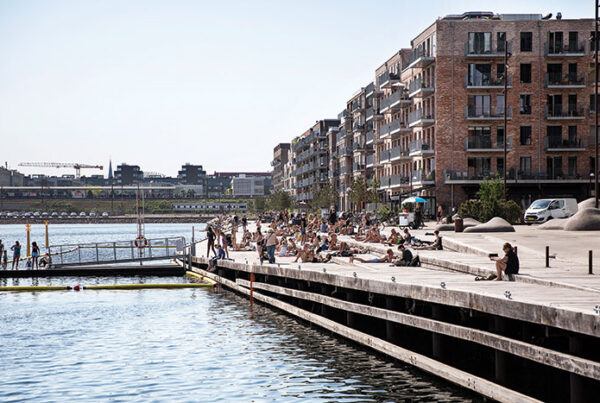
Commons Park lies just north of the confluence of Cherry Creek and the Platte River in Denver. (Shutterstock)
This interview was conducted on April 22, 2022, as part of a series designed to celebrate park visionaries and share inspiring and practical insights into their perspectives, challenges, and advice. Follow the series to learn from developers, planners, and other leaders creating innovative parks throughout the U.S.

Allegra “Happy” Haynes, executive director of the Denver Department of Parks and Recreation.
Allegra “Happy” Haynes is the current executive director of the Denver Department of Parks and Recreation. Appointed to this position in 2016, she has also been on the Denver Board of Education and has served as a Denver City Councilmember, both for over a decade. She is one of the smartest, most strategic, and strongest policy thinkers in the public sector. She serves on the boards of the Colorado Children’s Campaign, the Stapleton Development Corporation and Foundation, the Colorado Commission on Higher Education, the Colorado Council of the Trust for Public Land, and City Park Jazz.
Your passion for parks is palpable, and you have helped move the department forward in many ways. Why do you see parks—and the role they play in communities—as important?
The definition of parks is expansive; it is like the idea of blindfolded people touching a different part of an elephant and trying to explain what they are experiencing. Everyone touching the elephant has a different understanding of it. First, parks are places to commune with nature and, particularly in cities, a spot to find solace and respite from the daily grind of urban living. Parks promote fitness and culture. They serve as organic sponges to absorb various forms of pollution. People like to gather in parks to have picnics, listen to music, hang out with family and friends and experience art and culture in places that are inherently public and safe. Parks are one of the most democratic spaces or places that we have in our communities—they are everyone’s backyard.
You have been the director of Parks and Recreation for over six years. How did you get started on this journey?
I have a long personal history with parks. As a child, I lived near a large regional park in my hometown and walked to and from school through the park. I had an intimate relationship with the amazing park and became a nature lover. That led to my involvement as a volunteer in several different conservation organizations. In my government career I held various elected and appointed positions and never expected to focus on parks and recreation. However, when the Denver Mayor asked me to take on the role, I realized that this position combines my passion for governance and education and parks and open space.
One of my greatest joys is introducing young people to the idea of environmental stewardship. I believe that parks are a key part of civic infrastructure to determine the quality of urban life. They are not luxuries but essential ingredients for community life for all. I think that all the disciplines related to city building and real estate must be involved in decisions about parks, expanding the thinking of what parks mean with a multi-sector approach. Both mental and physical health are at stake, and there is a world of possibilities for how we use large spaces, remnants, triangles, and edges to turn all urban spaces into assets. It’s a naturally inherent view that open space is beneficial, but I have been determined to place an intentional focus on programs and research for parks to contribute to health and wellbeing.
Tell me about a park that is meaningful to you.
There is a great park example in Denver that was begun by a key local environmental activist from north Denver named Lorraine Granado. This project changed the way of thinking about parks across Denver to acknowledge the inequities in the system. In a community that was bisected by a highway and sited on the edge of heavy industrial uses there were a lot of negative environmental conditions. In the mid-1990s, the community filed a class action lawsuit against a metals refinery that contaminated air and soil in their Denver neighborhood. They won $28 million worth of environmental remediation. In addition, they filed another lawsuit when a railroad tanker car leaked gallons of acid into the air a few feet away from a park and community center in the neighborhood. After a long, contentious process, they got a $200,000 settlement to purchase nearby land and make it into a park and part of the fund was available for benefits and enhancements beyond cleanup.
Because of the early efforts in the ’90s, the thinking in Denver about how to invest in parks and facilities has changed. Instead of decisionmakers who hold the traditional power making all the decisions about parks, leadership is being provided by neighborhood residents who understand the needs of the community because they live in the community and experience the park on a day-to-day basis. Projects throughout Denver are now being conceived to reverse the long legacies of inequities. In February 2022, the City Council agreed to rename the park after Lorraine Granado, the community leader and activist who had a profound impact in her community.

Denver’s Nettie Moore Playground, an infill park named after a community activist with proximity to the Lakewood Gulch Trail and the city’s W Line light rail. (Jeffrey Beall/Flickr)
Related to the environmental justice issues you just brought up, how do you think parks contribute to finding justice, freedom and power for those who have been overlooked and left out of civic dialogue in the past?
Denver, along with many other cities, has adopted a goal to have all residents be within a 10-minute walk of quality open space. The Department of Parks and Recreation took existing data from the City’s Equity Index and overlaid it with information about the location of quality parks and the city’s investments in neighborhoods for the last decade to create the Parks and Recreation Equity Index map. The result is a map that defines our department’s priorities for the future by identifying where we need to make more investments and pay more attention to various communities. This has led to investment based on the change in how the Parks Department incorporates specific neighborhood factors and values as they make decisions.
All decision making is now driven by neighborhood engagement. Former brownfields are being identified and improved, taking detrimental places and turning them into neighborhood amenities. The culture of a community plays a vital role in the process and new facilities are designed to acknowledge and highlight the different cultures across Denver. For example, the city got a grant to install a creative, innovative playground in a very large, highly used park. There was intense neighborhood resistance from residents who didn’t want the change and new structures that might replace more grass and trees and quiet use.
The staff refocused on one of the lowest income neighborhoods in West Denver that lacked amenities. Even though there was disinvestment in this area previously, we wanted to let them know that they deserved THE BEST we have to offer. The new park built in the neighborhood became a destination park that is connected to the West Line Light Rail Station and the Lakewood Gulch trail. The park provides a complex and multi-faceted experience that challenges and engages users of all ages, abilities, and backgrounds. The playground is themed around music and the main activity structure looks like a giant old-fashioned microphone. It was designed as a tribute to the Park’s namesake, Paco Sanchez, who was the founder of the first Spanish language radio station in Denver. Our contractors who built the park bring people to see it because they are so proud of the project.
What are some of the main issues you are concentrating on in park management and development that may not have been on the radar when you took the position six years ago? What would you pursue if you had unlimited funds?
Our department plays a major role in the city beyond just providing open space and active recreation. One thing I didn’t anticipate was the music promotion and event business at our park venues. Everyone wants to have a wedding in a park!
We think about parks as part of a solution to climate change, habitat preservation and urban wildlife health. Since most parks were created early on with trees not native to Denver, we are converting traditional parks to native landscapes more conducive to our climate. We are replacing some of our grass areas with more native plantings that help clean the air and water and attract pollinators. We are starting more transformative projects that reclaim and clean up areas that were environmental messes.
We received a federal grant ($350 million) and the City will add $200 million to begin restoration of the South Platte River that flows 11 miles through the city and was previously channelized. We are focusing on the river as an amenity instead of a dumping ground, and highlighting its importance for many things, including being part of the central flyway bird migration from the northern states. We will most certainly need additional funds for this project but we are off to a good start.
When I was growing up, I loved to be outdoors but never understood the potential for people like me to work in parks and recreation, landscape architecture or other nature-based professions. I would like to expand opportunities for the industry to become more inclusive. For example, the tree industry in Denver is not very diverse or inclusive and doesn’t involve many people of color. With more funds we could create programs to train youth in park maintenance and stewardship and create workforce opportunities for them in this field, working to build the future leaders in the parks industry.
What should ULI members remember when imagining park projects?
We learned during the pandemic that parks have extraordinary value beyond measure. Parks saved the city’s sanity. ULI members are at the forefront of multidisciplinary city building and should be beating the drum about the importance of parks and recreation to bring people together and build community. They need to understand and pursue the idea that parks are a key part of city infrastructure.
The entire real estate industry needs to understand that we have a unique responsibility to transform how we think about diversity and environmental justice in parks development. We need to create opportunities for those who have been left out of the process of planning and building our cities in the past.
See the ULI publication Five Characteristics of High-Quality Parks to learn more about work on park quality in Denver and in other U.S. cities.



